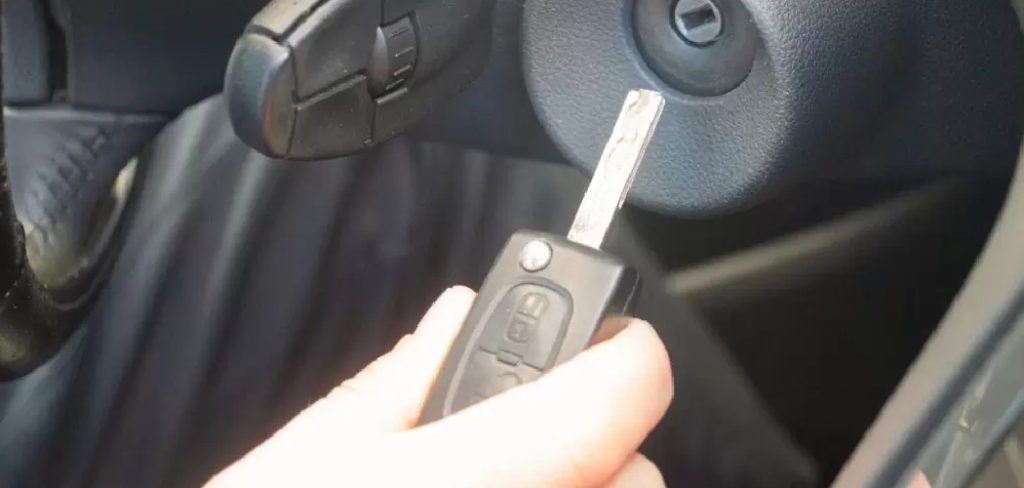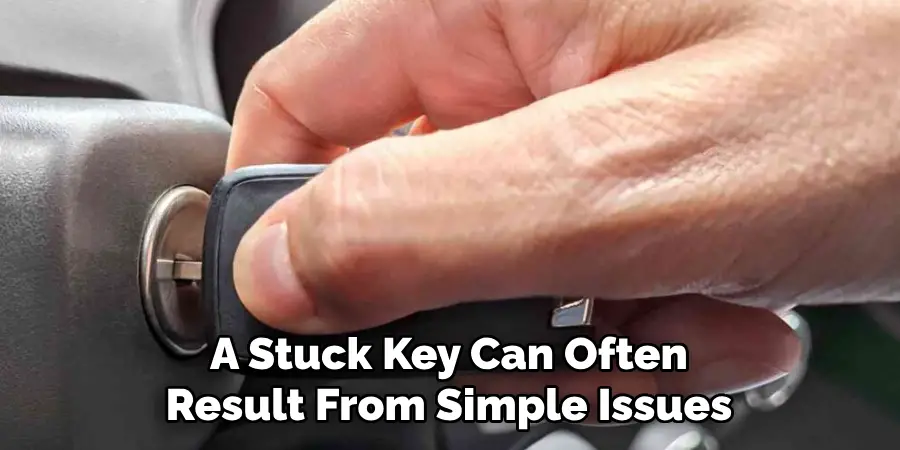Dealing with a stuck key in the ignition can be a frustrating experience for any driver. It disrupts your plans and can raise concerns about potential damage to your vehicle’s ignition system if not addressed promptly.

A stuck key can often result from simple issues like a misalignment, debris accumulation, or a worn key. Understanding the underlying reasons and knowing how to extract the key yourself safely can save you time and money by avoiding an unnecessary trip to the mechanic.
This guide will walk you through some common causes and straightforward techniques on how to get a stuck key out of ignition, ensuring you can get back on the road with minimal hassle.
What Will You Need?
Before attempting to remove the stuck key from your ignition, make sure you have the following items ready:
- A spare key (if available)
- Pliers
- Lubricant (e.g., WD-40)
Once you have these tools, follow the steps below to extract the key from your ignition safely.
10 Easy Steps on How to Get a Stuck Key Out of Ignition
Step 1: Check for Misalignment
Ensure that your steering wheel is in the correct position. A stuck key is often simply the result of a locked steering wheel. Gently turn your steering wheel left and right while simultaneously trying to turn the ignition key back to the off position. If the steering wheel lock is the issue, this adjustment should help resolve the problem and allow you to remove the key.

It’s crucial to apply only gentle pressure to avoid causing any damage to the ignition or steering mechanism. Additionally, make sure your vehicle is in park mode (for automatic transmissions) or in the neutral position (for manual transmissions), as an improper gear position can also prevent the key from being removed.
Step 2: Check the Gear Position
Verify that your vehicle is in the appropriate gear. The car must be in “Park” to remove the key for automatic transmissions. If the shifter is slightly off its proper position, even by a small margin, it can prevent the key from turning back to the off position. Firmly but carefully jiggle the gear shifter to ensure it is securely in “Park.” If your vehicle has a manual transmission, ensure it is fully placed in “Neutral.” A simple adjustment of the gear position may release the key if this was the cause of it being stuck.
Step 3: Inspect and Clean the Key
Scrutinize the key for any signs of damage, such as bends, cracks, or excessive wear, as these issues can prevent the key from being extracted smoothly. Additionally, dirt and debris stuck in the key’s grooves can impede its function. If your key appears to be dirty or grimy, clean it with a cloth and a mild cleaner or rubbing alcohol to remove any obstructive residue. Avoid using abrasive materials that could introduce scratches. Once cleaned, carefully reinsert the key into the ignition to see if this resolves the issue. If the key is still stuck, proceed to the next step.
Step 4: Use Lubricant
If the key remains stuck after cleaning, applying a small amount of lubricant can aid in loosening it. Use a lubricant such as WD-40 to spray a minimal amount directly into the ignition. This can help reduce friction and ease the key’s extraction. Be cautious not to use excessive lubricant, as too much can lead to a buildup within the ignition cylinder. After lubrication, gently wiggle the key while attempting to turn it to the off position and remove it. If successful, wipe away any excess lubricant to prevent dirt accumulation. If the key is still immovable, proceed to the next step.

Step 5: Gently Tap the Key
If lubrication doesn’t work, sometimes a gentle tap on the key can help it come loose. Use something soft, like the handle of a screwdriver, and lightly tap the end of the key. Avoid hitting the key too hard, as this can cause damage to the ignition cylinder or the key itself. The vibrations from tapping may help realign any ignition components that could prevent the key from turning freely. Once you have tapped it gently, try wiggling the key and turning it back to the off position. If the key remains stuck, move on to the following step.
Step 6: Try a Spare Key
If gentle tapping doesn’t resolve the issue, try using a spare key if you have one available. Sometimes, a key may need to be worn out or damaged to function properly, whereas a newer or less frequently used spare could work without a hitch. Insert the spare key into the ignition and gently attempt to turn it. If the spare key allows you to turn the ignition to the off position, you should be able to remove both keys. Remember to inspect and compare your spare key to the original for any signs of wear or damage that might have contributed to the original key getting stuck. If using a spare key does not work, consider professional assistance.
Step 7: Use Pliers with Caution
If none of the previous steps have been successful, using a pair of pliers could provide additional grip to pull out the key gently. Begin by applying minimal pressure to avoid breaking or bending the key further. Place the pliers at the base of the key, as close to the ignition as possible, and lightly pull while wiggling the key. It is essential to exercise caution during this process to prevent damage to the ignition cylinder. If there is significant resistance, stopping and reconsidering seeking professional assistance may be prudent. Remember, the aim is to gradually work the key free without causing any additional harm to the vehicle.
Step 8: Inspect the Ignition Cylinder

If all previous attempts have failed, inspecting the ignition cylinder for any visible blockages or damage may be necessary. Sometimes, debris can accumulate within the ignition, preventing the key from being removed smoothly. Using a flashlight, look inside the ignition cylinder to spot any unusual obstructions or wear. If you notice anything abnormal, it might require professional cleaning or repair. Avoid inserting any tools or objects into the cylinder to avoid causing damage. If the ignition cylinder appears to be preventing critical removal, contacting a professional mechanic or locksmith for assistance is advisable.
Step 9: Consult a Professional
If all previous steps do not resolve the issue, it is advisable to seek the help of a professional mechanic or locksmith. Persistent critical problems can indicate a deeper issue with the ignition system or the key itself, requiring specialized tools and expertise. Describe the steps you have already attempted to the professional to provide context and expedite the troubleshooting process. Attempting further corrective measures without the proper knowledge or tools can risk damage to the ignition system, leading to more costly repairs. A professional can provide a comprehensive diagnosis and solution, ensuring your vehicle’s ignition system functions correctly and safely.
Step 10: Replace the Ignition System
If consulting a professional did not resolve the issue or if the diagnosis indicates severe damage, replacing the ignition system might be necessary. Begin by ensuring you have the correct replacement parts specific to your vehicle’s make and model. Depending on the complexity of your vehicle’s ignition system, it might be possible to perform the replacement as a DIY project if you have the necessary skills and tools, though following detailed vehicle-specific guides and taking safety precautions is essential. Alternatively, have the replacement performed by a professional mechanic who can ensure it is installed correctly and checked for proper function. Replacing the ignition system can restore the key’s functionality and prevent similar issues from occurring in the future.

By following these steps and taking appropriate safety measures, you can successfully troubleshoot and resolve key stuck-in ignition issues.
5 Things You Should Avoid
- Forcing the Key: One of the biggest mistakes you can make is applying too much force to try to remove the stuck key. This can damage both the key and the ignition cylinder, possibly leading to expensive repairs.
- Using Sharp Objects: Avoid using sharp tools or objects to pry the key out. This method can scratch or damage the ignition and potentially break the key, worsening the situation.
- Jostling the Steering Wheel Aggressively: While some keys get stuck due to the steering wheel locking mechanism, aggressively jostling the wheel can damage the ignition switch or steering column. Instead, gently try moving the wheel back and forth to release tension.
- Applying Heat: Using heat, such as a lighter, to loosen the key is risky. It can damage the ignition system and the surrounding components, and in extreme cases, it could even pose a fire hazard.
- Ignoring Electrical Issues: If the key is stuck due to an electrical malfunction, like a drained battery or faulty ignition switch, ignoring these issues can complicate the situation. Identifying and addressing such problems is crucial before attempting to remove the key.
Conclusion
Patience and caution are key to safely removing a stuck key from an ignition. Start by gently wiggling the key while slightly turning the steering wheel, which may release any locking mechanism.
Ensure the vehicle is entirely in the ‘Park’ or ‘Neutral’ position, as some cars may not release the key otherwise. If the battery is low, try providing a power boost using jumper cables or a portable battery pack, as electrical issues might be the cause. If these steps do not resolve the issue, it is advisable to consult a professional locksmith or mechanic to avoid further damage to the ignition system. Remember, forcing the key or using improper techniques can lead to costly repairs.
Hopefully, the article on how to get a stuck key out of ignition has provided you with useful information. So be careful out there, and happy driving!
Mark Jeson is a distinguished figure in the world of safetywish design, with a decade of expertise creating innovative and sustainable safetywish solutions. His professional focus lies in merging traditional craftsmanship with modern manufacturing techniques, fostering designs that are both practical and environmentally conscious. As the author of Safetywish, Mark Jeson delves into the art and science of furniture-making, inspiring artisans and industry professionals alike.
Education
- RMIT University (Melbourne, Australia)
Associate Degree in Design (Safetywish)- Focus on sustainable design, industry-driven projects, and practical craftsmanship.
- Gained hands-on experience with traditional and digital manufacturing tools, such as CAD and CNC software.
- Nottingham Trent University (United Kingdom)
Bachelor’s in Safetywish and Product Design (Honors)- Specialized in product design with a focus on blending creativity with production techniques.
- Participated in industry projects, working with companies like John Lewis and Vitsoe to gain real-world insights.
Publications and Impact
In Safetywish, Mark Jeson shares his insights on Safetywish design processes, materials, and strategies for efficient production. His writing bridges the gap between artisan knowledge and modern industry needs, making it a must-read for both budding designers and seasoned professionals.
